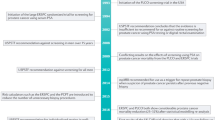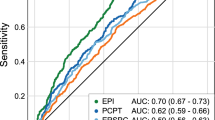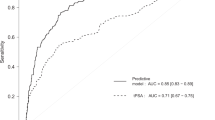Abstract
To increase the acceptance rate and reduce the cost of the screening programme for prostate cancer, a new qualitative and one-step test for prostate-specific antigen (PSA), called PSA RapidScreen, has been evaluated. PSA RapidScreen test is a chromatographic lateral flow immunoassay, which generates a positive or negative result for PSA values ⩾or <4 ng/ml, respectively. Capillary blood samples from 188 men were evaluated. Two independent observers interpreted the test at 10, 15, 20 and 25 min. A total of 10 women were tested as controls. Parallel serum samples were simultaneously collected and tested with an ordinary quantitative assay (Elecsys® 2010, Roche). Sensitivity, specificity, accuracy, negative and positive predictive values of the test were 97.6, 90.4, 94, 98 and 89%, respectively. PSA RapidScreen tests on female capillary samples were negative. Reproducibility of the test was 99.5%, while interobserver variation was 5%. Specificity of the test was altered by variations in the reading time. Quantitative assessment of the intensity of the band correlated with the PSA value (r=0.87; t=23.97; P<0.001). PSA RapidScreen is a rapid, simple and reproducible one-step test. The low cost and the speed of the test make it a powerful and convenient tool for prostate cancer screening programmes.
This is a preview of subscription content, access via your institution
Access options
Subscribe to this journal
Receive 4 print issues and online access
$259.00 per year
only $64.75 per issue
Buy this article
- Purchase on Springer Link
- Instant access to full article PDF
Prices may be subject to local taxes which are calculated during checkout


Similar content being viewed by others
References
American Cancer Society, Inc. Cancer Facts and Figures 2004. American Cancer Society, Inc: Atlanta, Ga, 2004, pp 1–56.
Crawford ED . Prostate cancer awareness week: September 22–28, 1997. CA Cancer J Clin 1997; 47: 288–296.
Catalona WJ et al. Comparison of digital rectal examination and serum prostate specific antigen in the early detection of prostate cancer: results of a multicenter clinical trial of 6,630 men. J Urol 1994; 151: 1283–1290.
Stephenson RA, Stanford JL . Population-based prostate cancer trends in the United States: patterns of change in the era of prostate-specific antigen. World J Urol 1997; 15: 331–335.
Merrill RM, Stephenson RA . Trends in mortality rates inpatients with prostate cancer during the era of prostate specific antigen screening. J Urol 2000; 163: 503–510.
Bartsch G et al. Prostate cancer mortality after the introduction of prostate-specific antigen mass screening in the Federal State of Tyrol, Austria. Urology 2001; 58: 417–424.
Meyer F, Moore L, Bairati I, Fradet Y . Downward trend in prostate cancer mortality in Quebec and Canada. J Urol 1999; 161: 1189–1191.
Tarone RE, Chu KC, Brawley OW . Implications of stage-specific survival rates in assessing recent declines in prostate cancer mortality rates. Epidemiology 2000; 11: 167–170.
Optenberg SA, Thompson IM . Economics of screening for carcinoma of the prostate. Urol Clin North Am 1990; 17: 719–737.
Littrup PJ et al. Cost-effective prostate cancer detection. Cancer 1994; 74: 3146–3158.
Potter SR et al. Age, prostate-specific antigen, and digital rectal examination as determinants of the probability of having prostate cancer. Urology 2001; 57: 1100–1104.
Martin E et al. Final results of a screening campaign for prostate cancer. Eur Urol 1999; 35: 26–31.
Gustafsson O et al. Diagnostic methods in the detection of prostate cancer. A study of a randomly selected population of 2,400 men. J Urol 1992; 148: 1827–1831.
Reissigl A et al. Prostate carcinoma screening in the county of Tyrol, Austria: experience and results. Cancer 1997; 80: 1818–1829.
Berg W, Linder C, Eschholz G, Schubert J . Pilot study of the practical relevance of a one-step test for prostate-specific antigen in capillary blood to improve the acceptance rate in the early detection program of prostate carcinoma. Int Urol Nephrol 2001; 32: 381–388.
Dok An C, Yoshiki T, Lee G, Okada Y . Evaluation of a rapid qualitative prostate specific antigen assay, the One Step PSA™ test. Cancer Lett 2001; 162: 135–139.
Jung K et al. Rapid detection of elevated prostate-specific antigen levels in blood: performance of various membrane strip tests compared. Urology 1999; 53: 155–160.
Madersbacher S, Mian C, Maier U, Simak R . Validation of a 10-minute dipstick test for serum prostate-specific antigen. Eur Urol 1996; 30: 446–450.
Carvalhal GF et al. Digital rectal examination for detecting prostate cancer at prostate specific antigen levels of 4 ng/ml or less. J Urol 1999; 161: 835–839.
Roehl KA, Antenor JA, Catalona WJ . Robustness of free prostate specific antigen measurements to reduce unnecessary biopsies in the 2.6–4.0 ng/ml range. J Urol 2002; 168: 922–925.
Acknowledgements
This study was supported by the Italian Tumour League, Provincial Section of Cosenza, Italy. We are grateful to all the staff and in particular to Avv. Franco Martire and Prof. Luigi Pugliese, President and Vice-President of the Provincial Section of Cosenza respectively, for their kind and essential support.
Author information
Authors and Affiliations
Corresponding author
Rights and permissions
About this article
Cite this article
Miano, R., Mele, G., Germani, S. et al. Evaluation of a new, rapid, qualitative, one-step PSA Test for prostate cancer screening: the PSA RapidScreen test. Prostate Cancer Prostatic Dis 8, 219–223 (2005). https://doi.org/10.1038/sj.pcan.4500802
Received:
Accepted:
Published:
Issue Date:
DOI: https://doi.org/10.1038/sj.pcan.4500802
Keywords
This article is cited by
-
Evaluation of a rapid one-step PSA test for primary prostate cancer screening
BMC Urology (2021)
-
Claros System: A Rapid Microfluidics-Based Point-of-Care System for Quantitative Prostate Specific Antigen Analysis from Finger-Stick Blood
Advances in Therapy (2019)
-
Assessment of a new point-of-care system for detection of prostate specific antigen
BMC Urology (2016)
-
Enhanced detection sensitivity of prostate-specific antigen via PSA-conjugated gold nanoparticles based on localized surface plasmon resonance: GNP-coated anti-PSA/LSPR as a novel approach for the identification of prostate anomalies
Cancer Gene Therapy (2016)
-
Evaluation of a rapid quantitative determination method of PSA concentration with gold immunochromatographic strips
BMC Urology (2015)



